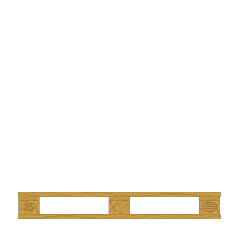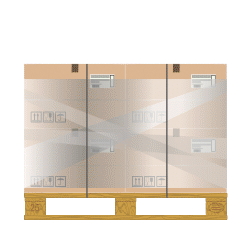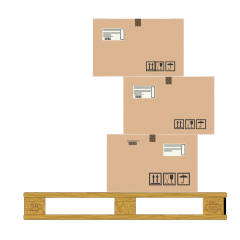Logistics 101
How to package heavy items for shipping
Proper pallet preparation is essential for safe transport. Follow this step-by-step guide to pack, wrap, strap, and label your pallet correctly before collection.
Step-by-step: Preparing a Pallet for Shipping
Step 1: Choose a Strong Pallet Base
Start with a quality pallet that can safely support your load:
- Use a Euro Pallet or UK pallet only. Our carrier networks handle UK (1200mm x 1000mm) and Euro (1200mm x 800mm) pallets. Do not use an American pallet, as it is not transportable through our services.
- Choose a 4-way pallet so it can be easily handled by a pump truck from any side.
- Check the pallet condition. Ensure the deck boards are intact, with no broken or missing slats. The pallet must be sturdy and in good condition.
- Heat treatment requirements: Some countries require heat-treated pallets. Please contact us to confirm before packaging your goods if you're shipping internationally.

A good quality pallet
Step 2: Stack and Stabilise the Load
Arrange your items carefully to create a stable, balanced load:
- Pack items in heavy-duty cardboard boxes for shipping. Triple-ply corrugated boxes offer the best protection.
- Keep heavier items at the bottom. This lowers the centre of gravity and maintains balance during transport.
- Place delicate items towards the centre of the pallet where they're better protected.
- Keep the height level on each layer and ideally ensure all items stay within the footprint of the pallet. If your goods do overhang, you'll need extra care with packaging — consider a custom pallet base and additional securing.
- Maintain even distribution across the pallet surface to prevent shifting.

A correctly loaded pallet

An incorrectly
loaded pallet

Goods should NOT
overhang the pallet
Step 3: Wrap the Pallet Securely
Shrink wrap (or stretch wrap) holds everything together and protects your goods:
- Start at the base. Tie a knot in one corner of the pallet base and walk around the pallet, wrapping the base 3 times over before moving upwards.
- Keep the wrap taut as you walk to ensure a tight, secure hold.
- Work your way up the pallet, overlapping each layer of wrap as you go.
- Capture the pallet base in the wrapping to anchor the load firmly.
- Cap off the top with multiple passes of shrink wrap to seal everything in place.
- Add corner protectors if needed to prevent damage to edges during handling.
Watch our video on: How to Shrink Wrap a Pallet
How to Shrink Wrap a Pallet
Step 4: Add Straps if Required
Ratchet straps provide extra security for heavier or taller loads:
- Use ratchet straps for loads that are particularly heavy, tall, or at risk of shifting.
- Position straps correctly to hold the load without crushing the goods.
- Tighten evenly using the ratchet mechanism — firm but not over-tightened.
- Check strap condition before use. Do not use damaged or frayed straps.
Watch our video on: How to use a ratchet strap
How to use a ratchet strap
Step 5:Label Clearly
Proper labelling ensures your pallet reaches the right destination:
- Print and attach shipping labels on the side of the pallet where they remain visible throughout transit.
- For extra safety, place one label on each side of the consignment to ensure at least one remains visible regardless of how the pallet is positioned.
- Use clear document pouches to protect labels from damage or weather.
- Include all essential details: sender address, recipient's full address, order reference, and service type.
- Add a return address in case of delivery issues.
How to Measure Your Pallet
Accurate measurements are essential for quotes and avoiding delays:
- Measure the length, width, and height of your pallet including all goods and packaging.
- Account for any overhang (though goods should ideally stay within the pallet footprint).
- Measure from the longest, widest, and tallest points to get the true dimensions.
Watch our video guide on: How to measure a pallet
How to measure a pallet
Additional Considerations
- For sea freight: Consider using a shipping carton (a pre-built wooden box) that affixes onto a pallet base for added protection during ocean transport.
- Collection and delivery: Please be advised that collections and deliveries are kerbside-to-kerbside. Pallets must be placed on a hard, even surface (i.e. concrete or tarmac).
Please note, these tips are general guidelines only and we can't be held responsible if your goods are damaged as a result of unsuitable packaging.
Frequently Asked Questions
Use a UK pallet (1200mm × 1000mm) or a Euro pallet (1200mm × 800mm) — 4-way entry only. Our carrier networks handle these two types. The pallet must be 4-way so a pump truck can lift from any side. Do not use American pallets; they aren't transportable through our services.
Yes — shrink wrap (stretch wrap) is essential. It secures goods to the pallet, prevents shifting, and protects from dust and moisture. Wrap the base at least 3 times, then work upward with taut, overlapping layers.
Use ratchet straps for heavier, taller, or higher-risk loads. If boxes are tightly packed and well shrink-wrapped, straps may be optional — but for valuable or fragile goods, add straps for extra security.
Aim to keep goods within the pallet footprint; oversized is possible with extra care. We can ship oversized pallets, but you should support overhang with a custom base, add extra wrap, and apply straps to prevent shifting. Robust packaging is required for safe handling — contact us for guidance.
Measure the full consignment: length, width, and height — including packaging. Measure from the longest, widest, and tallest points for accurate quoting and to avoid delays or extra charges. Our video guide shows the steps.
Have the right materials before loading. Heavy-duty cardboard boxes (triple-ply best), shrink/stretch wrap, shipping labels in a clear document pouch, plus optional corner protectors and ratchet straps. Ensure the pallet is sturdy and in good condition.
Heat treatment may be required for some international destinations. If shipping outside the UK, check requirements in advance. Heat-treated pallets carry the ISPM 15 stamp.
Heavy pallets need extra care and securement. Keep heaviest items at the bottom to lower the centre of gravity, use ratchet straps, and ensure boxes can bear stacked weight. Check network maximum weight limits with us.
Place labels on the sides and keep them protected and visible. Put at least one label on each side so one remains visible during transit. Use a clear document pouch and include sender/recipient addresses, order reference, and service type. Avoid placing labels on top where they may be covered or damaged.
Common mistakes to avoid: using damaged/poor-quality pallets, allowing overhang, inadequate shrink-wrap, putting heavy items on top of light ones, unclear labelling, and incorrect measurements before booking.
Yes — second-hand pallets are fine if they're sound. Check for intact deck boards, no broken/missing slats, and no protruding nails or major damage. For international shipping, confirm heat-treatment requirements.
Wrap the base at least 3 times, then continue upward with overlapping layers. Use more wrap rather than less for security. As a rough guide, a standard 500mm roll typically covers 2-4 pallets depending on height.